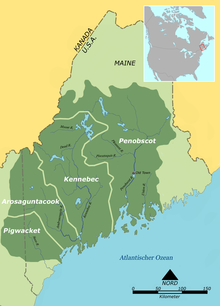 Approximate original location of the Pequawket (Pigwacket) and other Abenaki groups, ca. Approximate original location of the Pequawket (Pigwacket) and other Abenaki groups, ca. | |
| Total population | |
|---|---|
| extinct as a tribe in the early 19th century | |
| Regions with significant populations | |
| New Hampshire, Maine | |
| Religion | |
| Indigenous religion | |
| Related ethnic groups | |
| Other Abenaki peoples |
The Pequawket were a Native American band of Abenaki people. In the 18th century, they lived in New Hampshire and Maine.
Territory
The Pequawket lived near the headwaters of the Saco River and near what is now Carroll County, New Hampshire and Oxford County, Maine. Their primary town, also called Pequawket, was near Fryeburg, Maine.
Name
The etymology of Pequawket is disputed but might come from pekwakik, which translates "at the hole in the ground".
Their name is also spelled 'Pigwacket and many other spelling variants, and Dean Snow suggests it may have come from Eastern Abenaki apíkwahki, "land of hollows").
History
18th century
On April 16, 1725, the Pequawket fought the Battle at Pequawket against Captain John Lovewell and 50 English troops. The Pequawket killed Lovewell; however, the British killed Chief Paugus. After that skirmish, the Pequawket and the Arosaguntacook withdrew to the Connecticut River. The Arosaguntacook migrated north to Canada, where they settled in Saint-François-du-Lac, Quebec, while the Pequawket stayed there through the American Revolutionary War. Some returned to their homeland in the late 18th century.
Notable Pequawket
- Nescambious, an 18th-century Pequawket chief
- Molly Ockett (ca. 1740–1816), herbal healer and craftswomen
See also
References
- ^ "Molly Ockett and Her World". Bethel Historical Society. Retrieved 2017-11-12.
- ^ Hodge, Frederick Webb (1907). Handbook of American Indians North of Mexico: N-Z. Washington, DC: US Government Printing Office. p. 229.
- Snow, Dean R. 1978. "Eastern Abenaki". In Northeast, ed. Bruce G. Trigger. Vol. 15 of Handbook of North American Indians, ed. William C. Sturtevant. Washington, DC: Smithsonian Institution, pg. 146